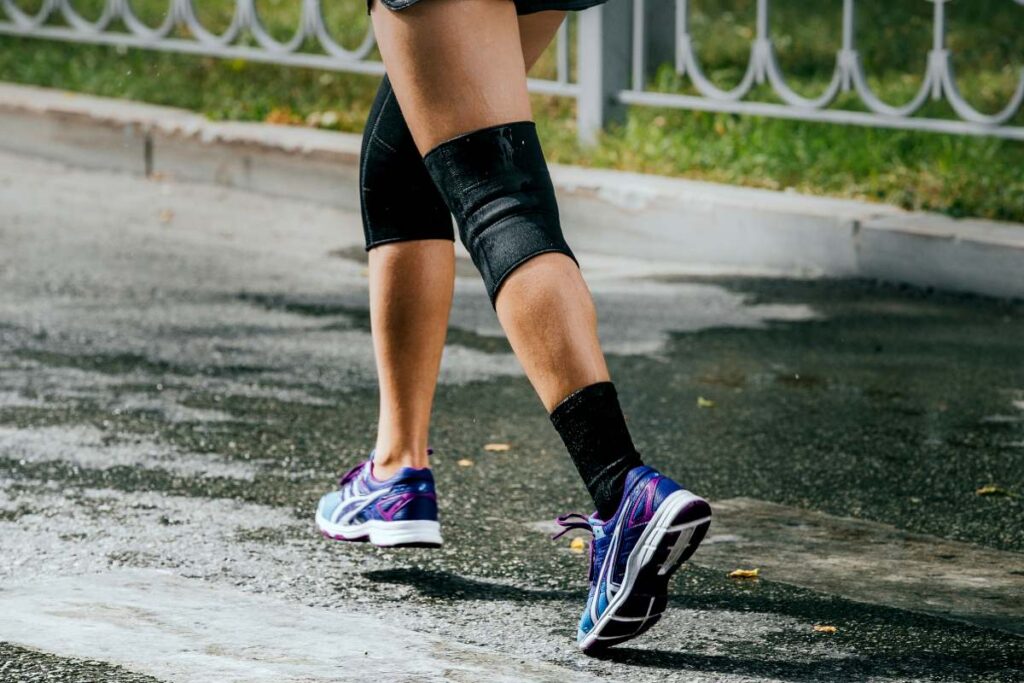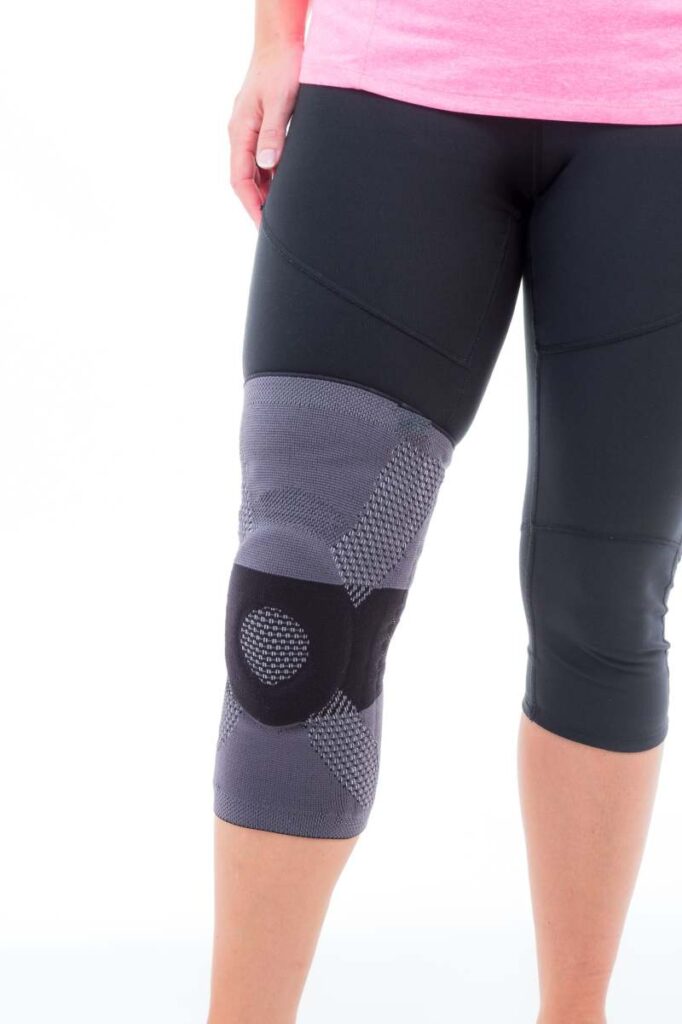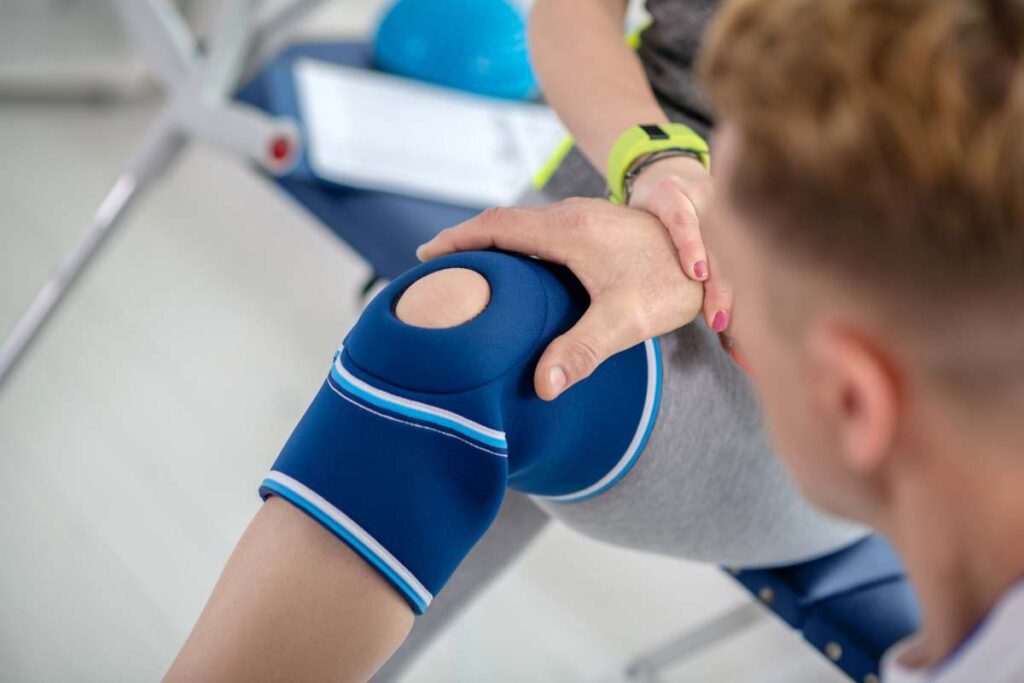Knee supports, like compression sleeves, are commonly used to reduce discomfort, prevent injuries, and aid recovery in people with knee issues.
Although these supports have many benefits, it’s important to know when to wear them and when to avoid using them to maximize their effectiveness and protect overall knee health.
In this article, we will discuss when wearing knee supports can be helpful and when it’s best to refrain from using them.
Related article:
What exactly is a knee compression sleeve?
A knee compression sleeve is a type of garment designed to provide support, stability, and compression to the knee joint. It’s typically made of a stretchy material like neoprene or nylon, which conforms to the shape of the knee and provides gentle pressure to the area.
These sleeves are commonly used by athletes, especially runners, basketball players, and weightlifters, to help prevent injuries, reduce swelling, and alleviate pain associated with conditions like arthritis or tendonitis. They can also improve blood circulation to the knee, which may aid in recovery from injuries or surgery.
Compression sleeves come in various sizes and styles, ranging from simple sleeves that slide over the knee to more complex designs with additional features like adjustable straps or silicone grips to keep them in place during physical activity

How do knee compression sleeves work?
Knee compression sleeves work through a combination of compression and support to provide several benefits:
- Compression: The primary function of knee compression sleeves is to apply gentle pressure to the knee area. This compression helps to improve blood circulation, which can reduce swelling and inflammation. It also provides support to the muscles, tendons, and ligaments surrounding the knee, promoting stability and reducing the risk of injury.
- Stability: By compressing the knee joint, the sleeve helps to stabilize the surrounding muscles and ligaments. This stability can be particularly beneficial during physical activity, as it can help prevent excessive movement or twisting of the knee, reducing the risk of strain or injury.
- Warmth: Knee compression sleeves also provide a degree of warmth to the knee joint. This warmth can help to increase flexibility and range of motion, making it easier to move the knee without discomfort or stiffness.
- Pain relief: The combination of compression, support, and warmth provided by knee compression sleeves can help to alleviate pain associated with various knee conditions, such as arthritis, tendonitis, or strains. By reducing swelling, improving circulation, and stabilizing the joint, compression sleeves can often provide effective relief from discomfort.
Overall, knee compression sleeves work by promoting better circulation, providing support and stability, and reducing pain and inflammation in the knee joint. They are commonly used by athletes and individuals with knee injuries or conditions to improve performance, prevent injuries, and aid in recovery.
When should I start wearing knee sleeves?
You can start wearing knee sleeves for various reasons and at different stages:

- Preventive Measure: If you’re engaging in physical activities that put stress on your knees, such as running, weightlifting, or sports like basketball or soccer, wearing knee sleeves preventively can help support your knees and reduce the risk of injury. Even if you haven’t experienced knee pain or discomfort yet, wearing sleeves can provide added stability and protection.
- During Recovery from Injury: If you’ve recently experienced a knee injury or surgery, your healthcare provider may recommend wearing knee sleeves as part of your rehabilitation process. Knee sleeves can provide support to the injured area, reduce swelling, and promote healing. However, it’s essential to follow your healthcare provider’s guidance regarding when to start wearing knee sleeves and how long to wear them during the recovery process.
- To Manage Chronic Conditions: If you have a chronic knee condition such as arthritis or tendonitis, wearing knee sleeves regularly can help manage symptoms like pain and inflammation. You can start wearing knee sleeves as soon as you experience discomfort or notice signs of swelling or instability in your knees.
- During Intense Workouts: If you’re engaging in intense physical activities or workouts that put extra strain on your knees, wearing knee sleeves can provide added support and stability, reducing the risk of overuse injuries or strains.
Ultimately, the decision to start wearing knee sleeves depends on your individual circumstances, such as your level of physical activity, any existing knee issues, and your healthcare provider’s recommendations. If you’re unsure whether knee sleeves are appropriate for you or when to start wearing them, it’s best to consult with a healthcare professional for personalized advice.

When should you not wear knee support?
While knee supports like compression sleeves can be beneficial in many situations, there are times when wearing them may not be appropriate or necessary:
- Certain Injuries: In some cases of acute injuries, such as severe ligament tears or fractures, wearing a knee support may not be recommended initially. These injuries often require immediate medical attention and immobilization, and wearing a knee support without proper diagnosis and treatment could potentially exacerbate the injury.
- Skin Irritation or Allergies: If you have sensitive skin or are prone to allergic reactions, wearing certain types of knee supports, particularly those made of neoprene or latex, may cause skin irritation or allergic dermatitis. In such cases, it’s best to avoid wearing knee supports that aggravate your skin condition.
- Impaired Circulation: Individuals with circulatory conditions like peripheral arterial disease may experience decreased blood flow to the legs and feet. Wearing tight knee supports, especially those that compress the area excessively, could further restrict blood flow and exacerbate circulation problems.
- Improper Fit: Wearing a knee support that doesn’t fit properly or is too tight can do more harm than good. A poorly fitting knee support may restrict movement, cause discomfort, or even contribute to injury by altering biomechanics. It’s essential to choose a knee support that fits snugly but comfortably and provides adequate support without excessive compression.
- Dependency: While knee supports can provide support and stability, relying on them excessively may lead to dependency and weaken the muscles around the knee over time. It’s essential to use knee supports as part of a comprehensive approach to knee health, including strengthening exercises and proper biomechanics.
- During Certain Activities: In some situations, such as swimming or activities that don’t involve weight-bearing on the knees, wearing knee supports may not be necessary or practical.
If you’re unsure whether wearing a knee support is appropriate for your specific situation, it’s best to consult with a healthcare professional, such as a doctor or physical therapist, who can provide personalized advice based on your individual needs and circumstances.
Final thought
Knee supports are crucial for maintaining knee health and improving performance for many people. It’s important to use them wisely to ensure they support rather than impede knee function and health. Following expert guidelines and consulting with professionals when necessary allows individuals to utilize knee supports optimally, enhancing comfort, stability, and the longevity of knee health.








